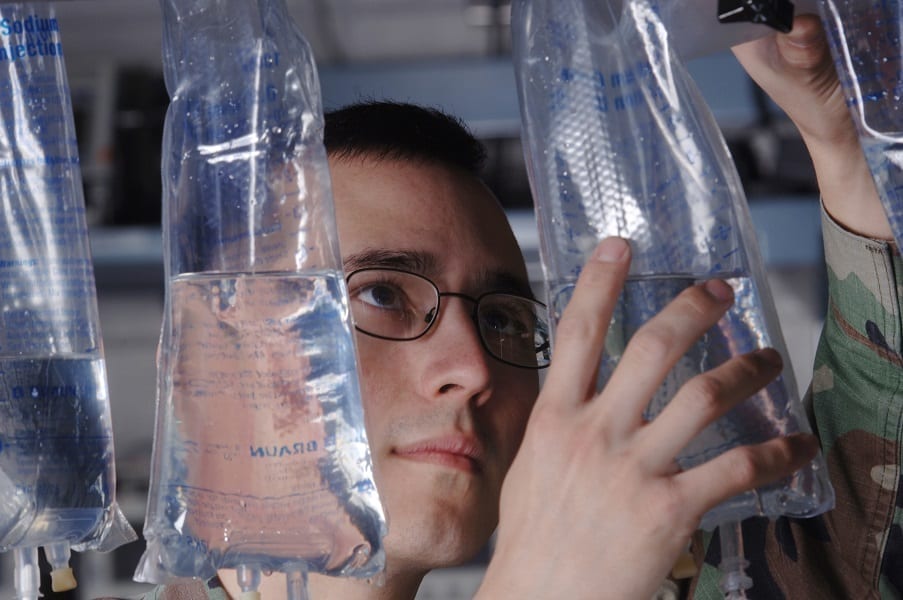U.S. hospitals are experiencing a shortage of IV bags since Hurricane Maria knocked out the major producer. Will we learn that efficiency is not terribly resilient?
When Hurricane Maria plowed through Puerto Rico and turned homes and hospitals into a heap of tembleque (only not nearly so sweet), it mucked up more than just the island’s medical infrastructure. Maria’s effects are being felt in hospitals far to the north as well. Baxter International, the biggest producer of small IV bags for U.S. hospitals, runs three manufacturing facilities in Puerto Rico. Although Baxter hurried to ship as many IV bags to the mainland as possible before the storm hit, the interruption to their production capacity is creating a shortage weeks after the hurricane.
Hospitals as far away as New England are feeling the pain. Vermont’s Brattleboro Memorial hospital has only a two month supply of IV bags on hand, while in New Hampshire, Cheshire Medical Center has even fewer. Brattleboro goes through about 320 of the mini IV bags each month. Hospitals have had to assist each other by lending supplies, and in some facilities they save on bags by having nurses spend more time manually injecting medications through an IV line or delivering oral versions of some drugs. Instead of automatically putting incoming patients on a saline drip, some hospitals are evaluating each person individually to see if they truly need fluids to be administered.
Baxter is still able to manufacture a limited supply of IV bags by running their factories on generators, but they are being strictly rationed. Puerto Rico’s lack of electricity and devastated roads and bridges mean that the IV bags they manage to make have a much harder time getting to market. They’re using smaller vehicles that can traverse ruined roads. Even so, hospitals all over the United States will be feeling the squeeze for months.

All of which is reminiscent of previous shortages. Due to centralized production of any number of goods, from IV bags to computer components, a single calamity can hobble a global market. In 2011, catastrophic floods covered a third of Thailand, displacing nine million people and disrupting the global supply of computer hard drives. Thailand is the number two producer of hard drives (after China). Likewise, Japan’s 2011 earthquake and tsunami dealt a serious blow to the global supply of memory chips since much of the world’s chip fabrication capacity is located near the quake epicenter or in areas that experienced power disruption.
It may be efficient to centralize the production of key goods, but when storms are expected to become both more common and more severe, it certainly isn’t resilient. Consider how much of the world’s food is produced in major “breadbasket” areas. A group of scientists recently found that in any given decade there is a 6% chance of simultaneous failure in the American and Chinese corn (maize) crop due to excessive heat, drought, or flooding. The impact of crop failure would be felt globally, especially in places where corn is eaten directly by people instead of being fed to livestock.
However, it doesn’t have to be this way. Disasters can and will happen; it’s how we deal with them that matters. If we’re smart, we won’t rebuild the status quo. Decentralizing the manufacture of critical goods and production of foodstuffs divides our eggs into many baskets. If some break, others may not. Producing goods closer to where they’re consumed can reduce the energy spent on transportation. Regional variations can provide for greater granularity, allowing communities to make better use of local resources and to create products more suited to local tastes, needs, and customs. Imagine traveling across the country and being able to enjoy the differences, instead of seeing the same big box stores and fast food restaurants at every freeway exit.
Efficiency and standardization are great ideas right up until the moment that we really need resilience. Let’s hope that as we rebuild Puerto Rico, companies decide to bring more IV bag manufacturing capacity closer to the heartland.
Related: Cheaper Healthcare: Waste Not, Want Less
Sources:
Hurricane Damage To Manufacturers In Puerto Rico Affects Mainland Hospitals, Too
Devastation in Puerto Rico puts squeeze on IV-bag supplies
Puerto Rico hurricane may cause shortage of hospital IV bags
Saline supply hamstrung by Puerto Rico disaster
Thailand Floods Cripple Hard Drive Supply Chain, Create Shortages
Memory chip prices surge in aftermath of Japan’s quake
Maize, rice, wheat: alarm at rising climate risk to vital crops
Rethinking the ‘Infrastructure’ Discussion Amid a Blitz of Hurricanes
Salvaging Resilience


Join the conversation!